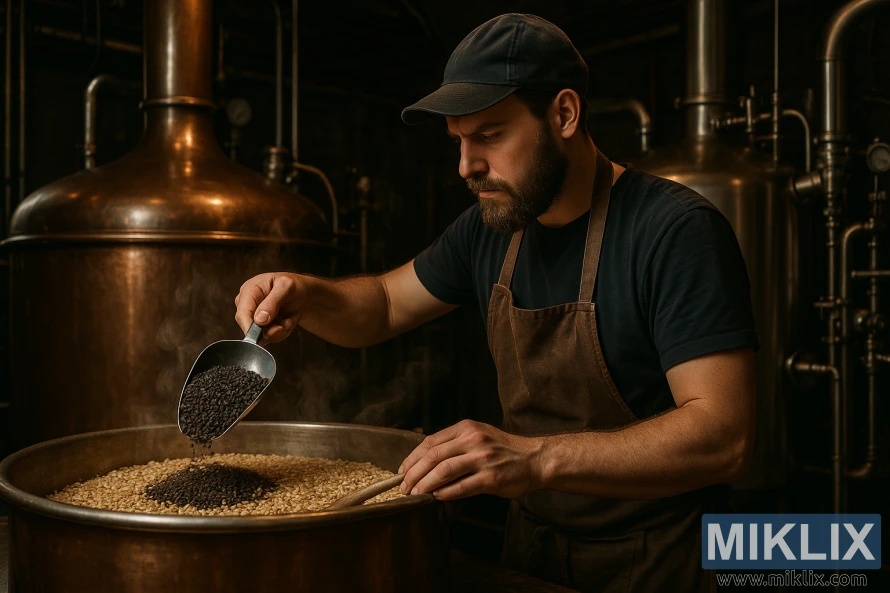Image: Brewing with Dehusked Carafa Malt
Published: July 24, 2025 at 7:37:07 AM UTC
Last updated: September 27, 2025 at 4:59:01 PM UTC
Dim brewhouse with copper kettles and steam as brewer measures dehusked Carafa malt, highlighting its smooth roasted flavor and artisanal brewing craft.
In the heart of a dimly lit brewhouse, a scene unfolds that speaks to the quiet intensity and craftsmanship of traditional brewing. The space is enveloped in a warm, amber glow, cast by strategically placed lights that bounce off polished copper kettles and gleaming stainless steel fixtures. Shadows stretch across the floor and walls, creating a moody, contemplative atmosphere that feels both industrial and intimate. Steam rises in soft, curling tendrils from the open mash tun, catching the light and adding a sense of motion and life to the otherwise still room.
At the center of the scene, a brewer stands poised over the vat, his posture steady and deliberate. Dressed in a dark t-shirt, a brown apron, and a cap pulled low over his brow, he exudes a quiet confidence born of experience. In one hand, he holds a metal scoop filled with dehusked Carafa malt—its grains dark, smooth, and richly roasted. The malt’s deep hues contrast sharply with the pale barley already resting in the vat, creating a visual metaphor for the balance he seeks to achieve in the final brew. With the other hand, he grips a wooden stirring paddle, ready to incorporate the specialty malt into the mash with care and precision.
The Carafa malt, known for its ability to impart color and roasted flavor without the harsh bitterness of huskier grains, is being added with intention. It’s a moment that requires not just technical knowledge but a sensory awareness of how each ingredient will interact. As the grains meet the hot water, the aroma begins to shift—notes of dark chocolate, toasted bread, and subtle coffee rise into the air, mingling with the ambient steam and filling the brewhouse with a comforting richness. The brewer leans in slightly, his eyes scanning the surface of the mash, watching for signs of proper integration and temperature stability.
Around him, the brewhouse hums with quiet energy. Copper piping snakes along the walls, connecting vessels and valves in a complex network that speaks to the sophistication of the operation. Stainless steel tanks stand like sentinels in the background, their surfaces reflecting the flickering light and the movement of steam. The floor, clean and slightly damp from earlier stages of the process, adds to the sense of a space in active use—functional, efficient, and deeply respected.
This moment, though seemingly routine, is a testament to the artistry of brewing. The brewer’s focused expression, the deliberate addition of the Carafa malt, and the careful stirring of the mash all reflect a commitment to nuance and quality. He’s not just making beer—he’s shaping an experience, crafting a beverage that will carry the subtle imprint of this exact moment, this exact choice. The use of dehusked Carafa malt ensures that the beer will have a smooth, roasted character without the astringency that can mar darker styles. It’s a decision rooted in both science and taste, one that reflects the brewer’s understanding of his ingredients and his vision for the final product.
In this warm, shadowed brewhouse, surrounded by steam and metal, the act of brewing becomes something more than a process—it becomes a ritual. The interplay of light, aroma, texture, and motion creates a scene that is both grounded and poetic, inviting the viewer to appreciate the depth of care that goes into every batch. The beer that emerges from this moment will carry with it the essence of roasted malt, the precision of its maker, and the quiet beauty of a craft practiced with devotion.
The image is related to: Brewing Beer with Dehusked Carafa Malt

